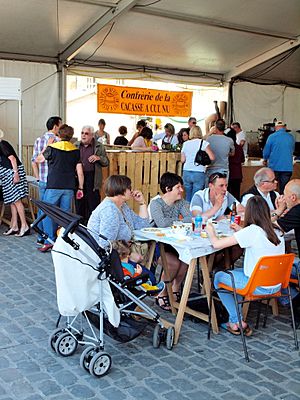Cacasse à cul nu facts for kids

Cacasse à cul culottée
|
|
| Course | Main course |
|---|---|
| Place of origin | France |
| Region or state | Ardennes |
| Associated national cuisine | France |
| Main ingredients | potatoes, bacon, onions |
| Similar dishes | Tartiflette, Bauernfrühstück |
Cacasse à cul nu is a special dish from the Ardennes region in France. It's a hearty meal made mainly with potatoes and onions, cooked slowly in a big pot called a Dutch oven. People often enjoy it with tasty bacon or smoked sausage.
The name "cul nu" means "bare bottom" in French. This used to mean the dish was served without meat. Instead, the pot was rubbed with bacon to add flavor. If the dish includes meat today, it might be called culottée (meaning "with underwear") or habillée (meaning "dressed").
History of Cacasse à cul nu
We don't know the exact date or place where Cacasse à cul nu first appeared. However, it likely comes from the Meuse valley in France. This dish was important for villagers who grew their own food and lived off their land. It was a way to make a filling meal from simple ingredients.
The dish is mentioned in old writings. For example, Gérard Gayot wrote about it in his book La Révolution en Ardenne from 1789–1792. Another writer, Jacques Lambert, talked about similar potato dishes like "potée roussie" or "frigousse" in the 19th and 20th centuries. These dishes were all about cooking potatoes with onions and lard.
Agnès Paris also wrote about "cacasse" being a special meal for people in Bogny-sur-Meuse during difficult times, like World War II. Françoise Branget also included the dish in her book La Cuisine de la République.
What is Cacasse à cul nu?
Cacasse à cul nu is a well-known symbol of Ardennaise cooking. Originally, it was a simple stew of potatoes and a thick sauce called a roux. It was cooked in a heavy cast-iron Dutch oven. This dish was often eaten by people who couldn't afford meat.
The phrase "À cul nu" meant that no meat was added to the dish itself. Only the fat from bacon was used to give it flavor. The bacon slices were not put into the stew.
Since 2001, a group called the "Confrérie de la Cacasse à cul nu" (Brotherhood of Cacasse à cul nu) has updated the recipe. Now, the dish is usually served with smoked sausage or slices of bacon. This makes it a heartier meal enjoyed by many.
See also
 In Spanish: Cacasse à cul nu para niños
In Spanish: Cacasse à cul nu para niños


